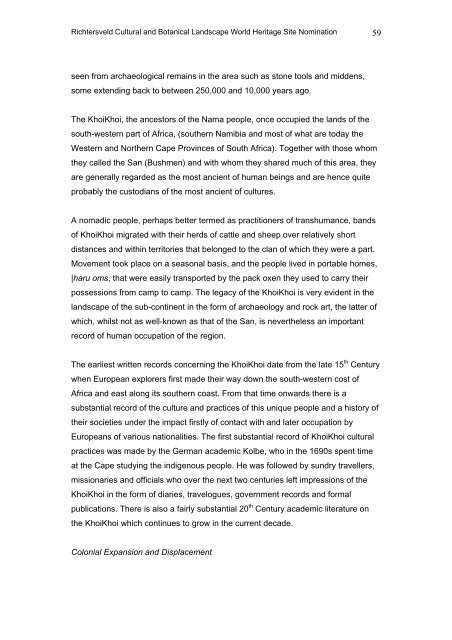the richtersveld cultural and botanical landscape - SAHRA
the richtersveld cultural and botanical landscape - SAHRA
the richtersveld cultural and botanical landscape - SAHRA
You also want an ePaper? Increase the reach of your titles
YUMPU automatically turns print PDFs into web optimized ePapers that Google loves.
Richtersveld Cultural <strong>and</strong> Botanical L<strong>and</strong>scape World Heritage Site Nomination 59<br />
seen from archaeological remains in <strong>the</strong> area such as stone tools <strong>and</strong> middens,<br />
some extending back to between 250,000 <strong>and</strong> 10,000 years ago.<br />
The KhoiKhoi, <strong>the</strong> ancestors of <strong>the</strong> Nama people, once occupied <strong>the</strong> l<strong>and</strong>s of <strong>the</strong><br />
south-western part of Africa, (sou<strong>the</strong>rn Namibia <strong>and</strong> most of what are today <strong>the</strong><br />
Western <strong>and</strong> Nor<strong>the</strong>rn Cape Provinces of South Africa). Toge<strong>the</strong>r with those whom<br />
<strong>the</strong>y called <strong>the</strong> San (Bushmen) <strong>and</strong> with whom <strong>the</strong>y shared much of this area, <strong>the</strong>y<br />
are generally regarded as <strong>the</strong> most ancient of human beings <strong>and</strong> are hence quite<br />
probably <strong>the</strong> custodians of <strong>the</strong> most ancient of cultures.<br />
A nomadic people, perhaps better termed as practitioners of transhumance, b<strong>and</strong>s<br />
of KhoiKhoi migrated with <strong>the</strong>ir herds of cattle <strong>and</strong> sheep over relatively short<br />
distances <strong>and</strong> within territories that belonged to <strong>the</strong> clan of which <strong>the</strong>y were a part.<br />
Movement took place on a seasonal basis, <strong>and</strong> <strong>the</strong> people lived in portable homes,<br />
|haru oms, that were easily transported by <strong>the</strong> pack oxen <strong>the</strong>y used to carry <strong>the</strong>ir<br />
possessions from camp to camp. The legacy of <strong>the</strong> KhoiKhoi is very evident in <strong>the</strong><br />
l<strong>and</strong>scape of <strong>the</strong> sub-continent in <strong>the</strong> form of archaeology <strong>and</strong> rock art, <strong>the</strong> latter of<br />
which, whilst not as well-known as that of <strong>the</strong> San, is never<strong>the</strong>less an important<br />
record of human occupation of <strong>the</strong> region.<br />
The earliest written records concerning <strong>the</strong> KhoiKhoi date from <strong>the</strong> late 15 th Century<br />
when European explorers first made <strong>the</strong>ir way down <strong>the</strong> south-western cost of<br />
Africa <strong>and</strong> east along its sou<strong>the</strong>rn coast. From that time onwards <strong>the</strong>re is a<br />
substantial record of <strong>the</strong> culture <strong>and</strong> practices of this unique people <strong>and</strong> a history of<br />
<strong>the</strong>ir societies under <strong>the</strong> impact firstly of contact with <strong>and</strong> later occupation by<br />
Europeans of various nationalities. The first substantial record of KhoiKhoi <strong>cultural</strong><br />
practices was made by <strong>the</strong> German academic Kolbe, who in <strong>the</strong> 1690s spent time<br />
at <strong>the</strong> Cape studying <strong>the</strong> indigenous people. He was followed by sundry travellers,<br />
missionaries <strong>and</strong> officials who over <strong>the</strong> next two centuries left impressions of <strong>the</strong><br />
KhoiKhoi in <strong>the</strong> form of diaries, travelogues, government records <strong>and</strong> formal<br />
publications. There is also a fairly substantial 20 th Century academic literature on<br />
<strong>the</strong> KhoiKhoi which continues to grow in <strong>the</strong> current decade.<br />
Colonial Expansion <strong>and</strong> Displacement

















